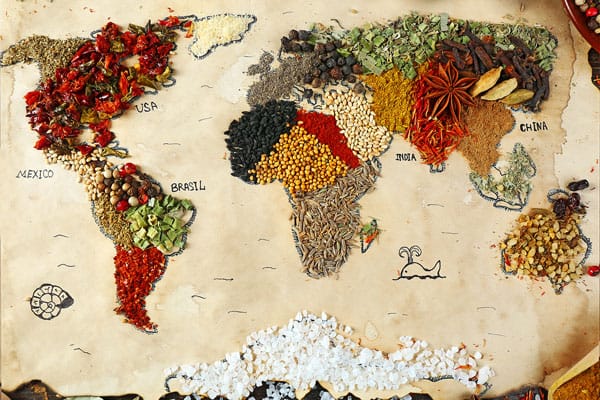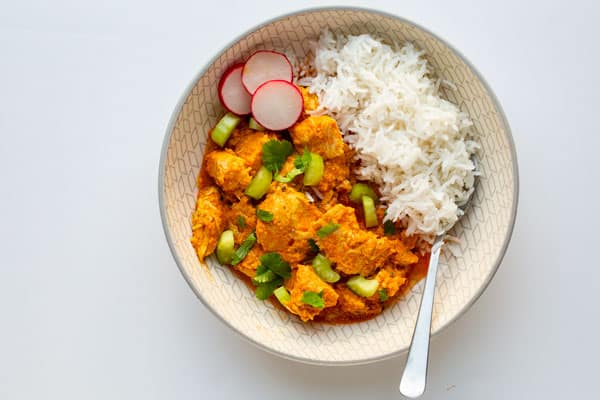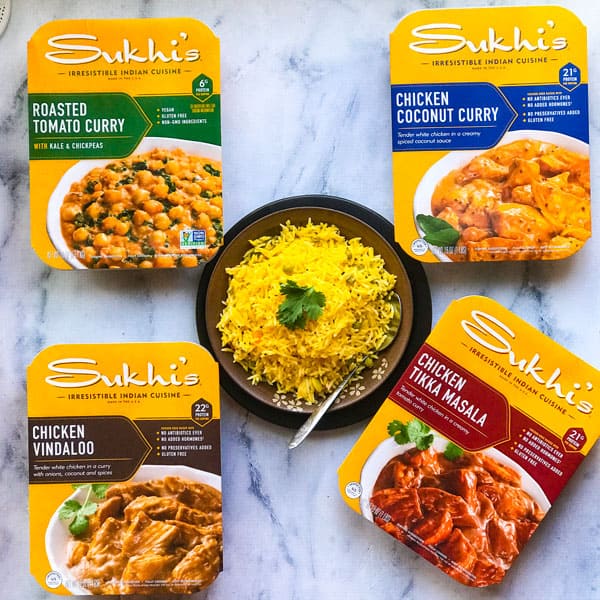What is Curry? Your Comprehensive Curry Guide
This curry guide breaks down curry’s origins, what curry powder is and how it differs from actual curry, the most popular types of curry, and more. If you’re asking yourself, “What is curry?” you won’t be after reading this!
The word curry immediately brings to mind an Indian delicacy—full of flavor and richness. One could say that it emulates the personality of its country of origin. Over the years, curry has evolved to become more than just food; it evokes an emotion—one of warmth, while tickling your taste buds and making your mouth water at the sheer thought of it! A simmering bowl of freshly made curry can take you on a journey of the senses. After all, very few dishes can contest this taste and aroma.
But what if we told you that curry is not a flavor, but rather that it simply means ‘sauce or gravy.’ This popular Indian dish is usually made with vegetables and meat and served over rice. It’s heavily spiced and is never lacking in taste. Curry can be mild or it can pack some serious heat, depending on your personal preference and tolerance for spicy food.
Curry is one of the most famous meals in Indian cuisine and never disappoints, especially if you have time and make some homemade. Intrigued? Read on as we decode curry for you in this comprehensive curry guide.
List of topics discussed in the article
In this post, we’re going to hit on everything you’ll need to know about curry, like:
What is Curry?
Origin of Curry?
What is Curry Powder?
Types of Curry
Sukhi’s Curries
What is Curry?
In its simplest form, curry is an Indian gravy or sauce that is used in tandem with meat, tofu, or vegetables. It’s served rice, most popularly Basmati rice, and contains many different kinds of spices. Depending on what your recipe calls for, you could have a mild curry or a curry that’s super spicy.
There are many different ways to make curry and each region will have its specialty. My family’s Chicken Tikka Masala could vary from your family’s recipe, and that’s okay! Curry is what you make it.
Origin of Curry
Curry has a charming history, one that points at many countries and their glorious cultures. Curries, from Southeast Asia to the Middle East to India, have been a staple of eastern cuisine for centuries. As one can see today, it has spread from its early origins to find a place on countless dining tables around the globe and is enjoyed by people of all ethnicities and nationalities the world over.
However, the truth is that no one really knows when curry was invented or started to be used in Indian cooking. What one knows is that the use of spices in a sauce to flavor meats has been traced back to 2500 BCE from Mohenjo-Daro. Archaeological evidence further showcases the use of a mortar and pestle to pound spices including mustard, fennel, cumin, and tamarind pods, with which food was flavored.
From there, it is thought that curries were spread across Asia and Europe via Indian monks traveling the Silk Route. Curries were also influenced by new world explorers from Spain and Portugal that brought chili peppers to India, prior to which the most pungent ingredient in curries was black pepper. The expansion of curries throughout Asia was further accelerated by the British that introduced Indian curries to Japan and hence one can say that the curry traveled to all British conquests.
What is Curry Powder
The word ‘curry’ comes from the Tamil word ‘kari’, which simply means ‘sauce’. In India and around the world, there are thousands of different types of curry. Its taste and consistency vary from place to place, accommodating as per the geography, availability of ingredients, and the cultural and religious preferences of the people residing in the specific region.
Curry powder, on the other hand, can fancily be termed as the potpourri of spices. Simply put, it is a ‘dry mixture of spices’ that goes into making any curry. On supermarket shelves, this mixture includes turmeric, ground coriander, ground cumin, ground ginger, and black pepper.
This modern version was concocted and brought to Britain from India by soldiers returning home during the British rule of India. The idea was to mix the common ingredients that went into making the most popular versions of Indian curry and achieve the same taste on the British soil.
However, this curry powder alone was never meant to flavor a dish, and it was certainly not meant to be used uncooked as a flavoring agent for ‘curry chicken salad’. The pungent flavor of curry chicken salad is one reason some people associate ‘flavor’ with the word ‘curry’.
The traditional method of using spices in curries is to make a ‘tarka’, or pan fry spices in oil. The heat releases the flavors and infuses them in the oil, which is then poured over the main ingredients. This process also mellows out some of the harsh tones of raw spice mixes.
History of Curry

Curry has a charming history, one that points at many countries and their glorious cultures. Curries, from Southeast Asia to the Middle East to India, have been a staple of eastern cuisine for centuries. As one can see today, it has spread from its early origins to find a place on countless dining tables around the globe and is enjoyed by people of all ethnicities and nationalities the world over.
However, the truth is that no one really knows when curry was invented or started to be used in Indian cooking. What one knows is that the use of spices in a sauce to flavor meats has been traced back to 2500 BCE from Mohenjo-Daro. Archaeological evidence further showcases the use of a mortar and pestle to pound spices including mustard, fennel, cumin, and tamarind pods, with which food was flavored.
From there, it is thought that curries were spread across Asia and Europe via Indian monks traveling the Silk Route. Curries were also influenced by new world explorers from Spain and Portugal that brought chilli peppers to India, prior to which the most pungent ingredient in curries was black pepper. The expansion of curries throughout Asia was further accelerated by the British that introduced Indian curries to Japan and hence one can say that the curry traveled to all British conquests.
Types of Curry
Given its extensive spread across the world and the many cultures that celebrate and enjoy a curry in their cuisine, we feel there is truly something special about curry and curry recipes. Whether you like it mild or extra spicy (Indian hot, as some people may say), curry is undeniably a comfort food that nearly everyone enjoys. And with the rise of vegetarian curries, an ever-increasing number of people are now being able to discover and relish its deliciousness.
Indian curries, in particular, are known throughout their home country as a dish that brings people together, either for a quick snack or a decadent meal shared by family and friends. This is a trend that has been brought to many countries with Indian communities, and undoubtedly when most people think ‘curry’, they think of delicious Indian food.
When looking at different curries, they usually have at least one or two things in common. Some of the most popular types of curries are red, yellow, green, massaman, panang. These curries vary depending on region, but have some similarities in their makeup, like chilies, veggies, and spices.
Popular Curries Around the World
The true glory of a dish really does lie in its adaptability, which is one of the many reasons why curry is a global phenomenon. Let’s look at how various regions have created their own unique curry.
Southeast Asia
Southeast Asian curries have a distinct taste and that comes from the usage of coconut milk. Some call it their power curry ingredient. This base is infused with spicy chillies, coriander, and garlic, but without the usual cumin that you would expect from an Indian curry. Even within countries, regional variants of curry dishes have developed. In Thailand, for instance, there are the green, red, and massaman curries, among others.
Popular Curries of Southeast Asia:
- Beef Rendang, Indonesia : Spicy, slow-cooked beef curry
- Kapitan Curry, Singapore: Least Spicy Malaysian Curry made with turmeric and shrimp paste
- Burmese Chicken Curry, Vietnam: A delicious combo of India and Thai flavors, like lemongrass and garam masala
East Asia
Japan was first introduced to curry by the British and hence, the taste was massively influenced by Indian curry. However, it became so popular that the Japanese adapted it to work a variety of vegetables like onions, potatoes and carrots into their version, while mixing it with the meat. Today, due to its uncontested popularity, some call it the national dish.
Popular East Asian Curries:
- Japanese Curry, Japan: A rich curry sauce served over rice
- Chinese Curry, China: Yellow curry with meat, fish, or vegetables
- Korean Curry: More of a stew-like consistency, it consists of chicken over rice
Middle East
Middle Eastern curries are often dry curries—cooked in a small amount, the sauce essentially evaporates and leaves the spices crusted on the meat. As you bite into the meat, you immediately taste the incredible mix of spices, which becomes the highlight of your experience!
Popular Middle East Curries:
- Mutton and Onion Curry with Whole Spice: Mutton and onion in a curry made of chilies, cinnamon, and other spices
Indian Curry

While there are practically as many Indian curry variations as there are provinces and sub-regions in India, many of the most popular dishes are recognizable the world over. We have the famed chicken tikka masala, vindaloo, and versions that led to the making of the legendary butter chicken. Among others are regional favorites like korma and chettinad curry and many more! Most any Indian restaurant in the world will feature some or all of these delicious offerings, just like we do at Sukhi’s.
Popular Indian Curries:
- Chicken Tikka Masala
- Chicken Vindaloo
- Korma Curry
- Chicken Biryani
- Chicken Coconut Curry
United Kingdom
British curry is modified off of Indian curry, so it makes sense that they are rather similar. In fact, one of the most popular curries in the UK is chicken tikka masala! Some of the earliest curries in the UK included a rabbit curry with an Indian pickle. Turmeric is arguably the most important ingredient in British curry. Likewise, curry is one of the most popular dishes in Britain.
Popular United Kingdom Curry:
- Chicken Tikka Masala
- Lamb Curry with Tomatoes
South Africa
One of the most popular South African curries, Durban curry, is comes with a long history of ingredients and is steeped in tradition. Durban curry has a deep-red color indicative of the spice level, oil, and, if it’s not a fish curry, large chunks of soft potatoes—known as “gravy soakers.”
Other Popular South African Curries:
- South African Beef Curry
- South African Chicken Curry
- South African Lamb Curry
West Indies
Bahamian and Jamaican-style curry are among the two most popular curries in the West Indies. Standard Bahamian curry is made with chicken and ghost pepper, so it doesn’t mess around in spiciness. Jamaican curry, on the other hand, uses chicken and has the option of adding in a habanero pepper so you can control the level of spiciness.
One can conclude then, that curry comes in many forms and with many flavors. Besides the few common ingredients between them all, it’s safe to say that what really makes a curry is this—its level of heat.
How to Make Curry
So, we’ve discussed the origins and different types of curry. But what about making curry yourself? Well, making a curry can be almost as enjoyable as eating it! You’ll first want to decide whether you’re starting from scratch, using a curry powder, or using a pre-made curry paste, such as those we offer through our inventory of sauces and pastes.
Many people enjoy making their own curry powders and adding something extra, such as seasoning salt, garlic, or other spices and flavorings. We’re confident in Sukhi’s secret recipe, but we encourage everyone to give their own version a try too! If you’ve never made homemade curry before, we recommend starting with a popular recipe like butter chicken or a more traditional chicken curry.
However, if you’re not quite ready for your own creation, the next step is to save time without sacrificing quality or deliciousness by using a ready-made paste. These help you quickly prepare delicious meals, such as Tikka Masala or Korma, with your chosen curry paste, meat and/or vegetables, and anything extra you want to add to match your palate!
Once the meal is prepared, serve it piping hot with fresh naan and some chutney. Whether it’s a lamb vindaloo, chicken tikka masala, or a vegetable korma, you’ll have a dish that’s sure to please any guest, friend, or family member.
A passion for enjoying Indian curry is what led to the spread of Indian cuisine all over the world. From ingredients to preparation to consumption, curry represents an Indian heritage dating back thousands of years, and it is one of the country’s proudest cultural exports. Its early origins across the Indian subcontinent and into Southeast Asia were just the beginning. Today, not only is curry enjoyed around the globe, new recipes and new curries are being developed too!
We hope that our exploration of curry has inspired you to get into the kitchen and start cooking! Our belief is that either through our passion, our products, or both, you will begin to enjoy Indian curry in a new light, seeing it for the rich cultural cuisine that it is. So, from all of us at Sukhi’s, happy eating!
Sukhi’s Curries

We have plenty of curries to choose from if you’re looking for somewhere easy (and delicious) to start.
India has many regional variations but everyone loves this dish of tender chicken, creamy tomato sauce and aromatic spices. Serve with warm Naan bread and Basmati rice.
This smooth, rich curry has the perfect amount of heat, balanced with creamy coconut milk and tangy tomatoes. Serve with warm Naan bread and Basmati rice, for a delicious journey to the coast of India.
Made with Halal chicken, this basic curry is served over Basmati rice with warm Naan bread.
Vindaloo gets its tangy, bold flavors from a blend of vinegar, ginger, garlic, and chilies. First introduced to India by the Portuguese as a type of stew, it’s now a staple on Indian menus everywhere. Served with warm Naan bread and Basmati rice.
Chicken with yogurt, creamy cashews with hints of turmeric and toasted spices. Serve with warm Naan bread over Basmati rice.
Roasted Tomato Curry combines wholesome spices such as turmeric and cumin with tomatoes and chickpeas to make an irresistible entrée. Adding kale with our traditional Chickpea Curry adds a nutritious modern twist to this classic Indian fare. Enjoy with Sukhi’s Lemon Rice.
If you’d like to cook some delicious Indian curry at home, let us give you a secret ingredient. No one would know it only took you minutes to put together a complex dish. Use Sukhi’s artfully mastered Curry Pastes. You can thank us later!
- Classic Indian Curry Sauce
- Tandoori Marinade
- Korma Curry Sauce
- Vindaloo Curry Sauce
- Tikka Masala Curry Sauce
- Madras Curry Sauce
12 responses to What is Curry? Your Comprehensive Curry Guide
[…] What is Curry? Your Comprehensive Curry Guide […]
[…] to list them out, but don’t worry – we’ve listed some of the more popular ones in our Comprehensive Curry Guide that also discusses the difference between curry and curry […]
[…] extensive post about curry will set you […]
Thank you helping me understand the history of curry. We live in West Virginia and when we travel near Cincinnati we always stop there for curry. The restaurant Guru India has a small grocery store in it and they had been very kind to me in telling me some spices to use so I’ve been able to make some curries at home. I never get bored eating curry.
Rick
Great and interesting info
[…] learned a lot about curry by reading this curry overview from Sukhis: "What is Curry? Your Comprehensive Curry Guide". I highly suggest reading it for more […]
[…] That said, the most popular variations are Pakistani karahi curry and also the Indian karahi curry. […]
[…] others add saffron, etc. Frankly, there are probably tens of thousands of curries around the world. Sukhis writes that curry: Its taste and consistency vary from place to place, accommodating as per the […]
How does curry relate to turmeric and cucurmin?? In what plant is it found?
Curcurmin is a bright yellow component found in the turmeric plant. Ground turmeric powder is often used in different curries, not only Indian curries but also Malaysian, Caribbean, and curries from all over the world.
[…] What is Curry? Your Comprehensive Curry Guide […]
[…] which is fitting since basmati smells quite nutty once cooked. It pairs exceptionally well with saucy curries, as the long rice grains soak up the extra […]